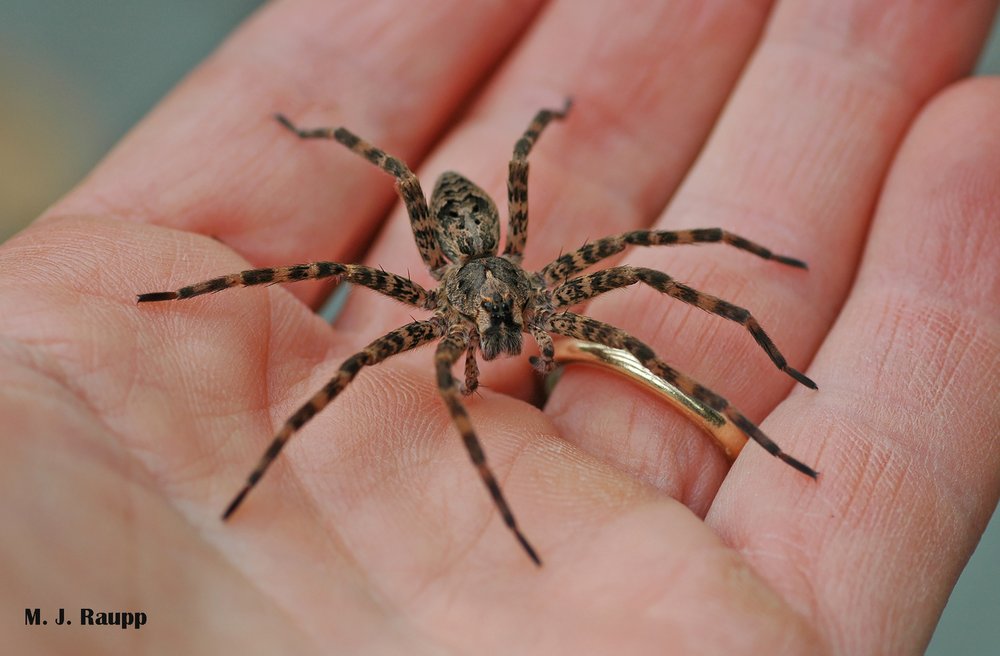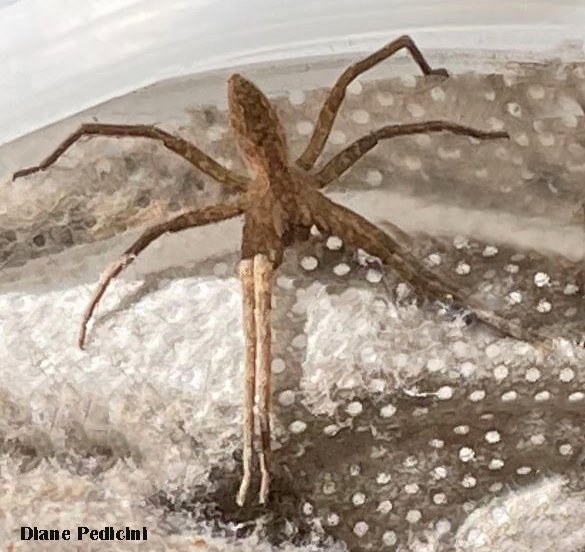From the Bug of the Week Mailbag: Who’s that big spider hanging out on my bedroom drape? Fishing spiders, Pisauridae

Sometimes found in homes, fishing spiders are among the largest of hunting spiders found in the DMV.

Discovering a large fishing spider hanging out on a bedroom drape can give one a bit of start. Image credit: Diane Pedicini
Recently we met two very large orb-weaving spiders, the golden silk spider and the Jorō spider, one of which, the Jorō, seems poised to expand its range northward along the eastern seaboard. But guess what? We already have several other impressively large spiders that are native residents in the DMV. Recently I received a text message from a friend with an image of a beautiful large fishing spider snuggled in the folds of a bedroom drape. Whether the spider had been loafing indoors all winter or simply moved in during a brief warm spell remains a mystery. Nonetheless, this oversized arachnid certainly left a memorable impression on my friend.
Fishing spiders, in the genus Dolomedes, are often found near or on water, but they also wander forests and suburban landscapes and make startling appearances in homes and outbuildings. On more than one occasion, fishing spiders have greeted me in the basement or when I opened the door of my tool shed. Fishing spiders do not build webs to capture prey. They actively hunt and consume a smorgasbord of aquatic and semiaquatic animals; vertebrates such as fish, tadpoles, and toads, and a wide variety of invertebrates, with damselflies, water striders, aquatic beetles, and midges commonly on the menu. As with many other species of spiders, they have the somewhat disturbing propensity to eat other members of their species including youngsters and, for the females, their suitors. Fishing spiders are patient, clever hunters. With hind legs anchored on shore and forelegs outstretched on the water, they capture prey on and just below the surface when hapless victims venture too near. Special non-wettable hairs on their legs allow fishing spiders to ride the surface tension of water, enabling them to run or sail across the surface of a pool or stream.
High on the Massanutten Mountain of Virginia a bench sits near a gentle stream, home to remarkable numbers of large fishing spiders. While the Zen-like tranquility of this spidery sanctuary may appeal to arachnophiles, arachnophobes may choose to relax elsewhere.
Members of the pisaurid clan also go by the name of nursery web spiders, so called for their habit of building a small web to serve as a refuge for tiny spiderlings emerging from an egg sac. Accounts suggest that fishing spiders can deliver a bite of similar severity to the sting of a bee or wasp. My experience with fishing spiders is that they are quite docile and willing to pose politely for photographs. However, I am not recommending that you try handling one. What of my friend and her fishing spider? She grabbed her handy spider-catching-cup, scooped up the spider, and released it back to the wild, a happy ending for human and spider.
Acknowledgements
Bug of the Week thanks Diane for sharing her image of a home invading fishing spider and providing inspiration for this episode. The excellent article “Prey use of the fishing spider Dolomedes triton (Pisauridae, Araneae): an important predator of the neuston community” by Manfred Zimmermann and John R. Spence provided a detailed dietary account of a common, widely distributed fishing spider.
To see a fishing spider capture a minnow, please click on the following link: https://www.youtube.com/watch?v=nEKRWEo1PSI
This post appeared first on Bug of the Week